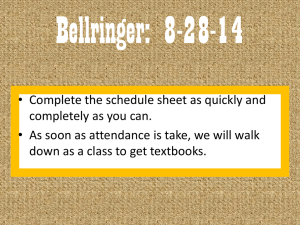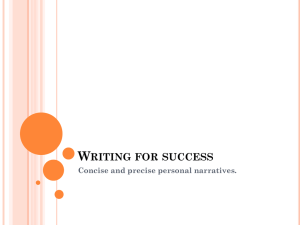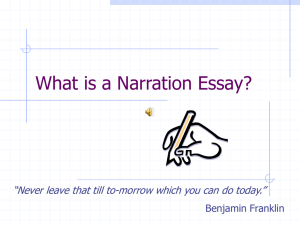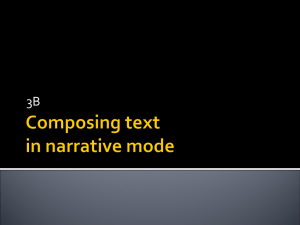Learning Sequence
advertisement
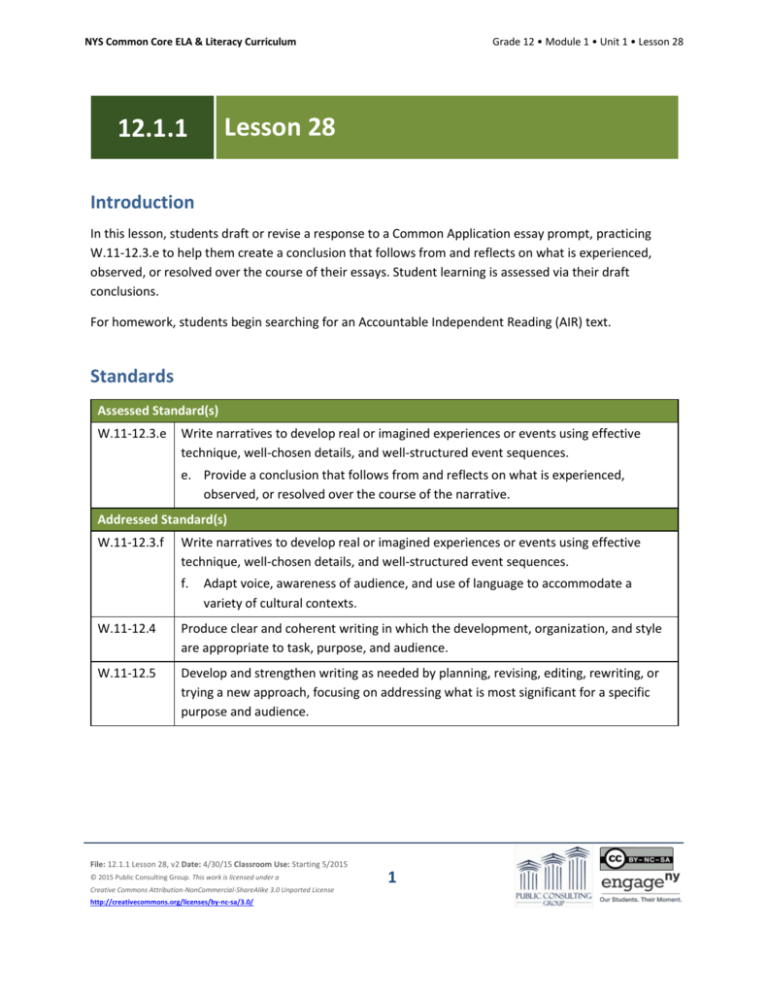
NYS Common Core ELA & Literacy Curriculum Grade 12 • Module 1 • Unit 1 • Lesson 28 Lesson 28 12.1.1 Introduction In this lesson, students draft or revise a response to a Common Application essay prompt, practicing W.11-12.3.e to help them create a conclusion that follows from and reflects on what is experienced, observed, or resolved over the course of their essays. Student learning is assessed via their draft conclusions. For homework, students begin searching for an Accountable Independent Reading (AIR) text. Standards Assessed Standard(s) W.11-12.3.e Write narratives to develop real or imagined experiences or events using effective technique, well-chosen details, and well-structured event sequences. e. Provide a conclusion that follows from and reflects on what is experienced, observed, or resolved over the course of the narrative. Addressed Standard(s) W.11-12.3.f Write narratives to develop real or imagined experiences or events using effective technique, well-chosen details, and well-structured event sequences. f. Adapt voice, awareness of audience, and use of language to accommodate a variety of cultural contexts. W.11-12.4 Produce clear and coherent writing in which the development, organization, and style are appropriate to task, purpose, and audience. W.11-12.5 Develop and strengthen writing as needed by planning, revising, editing, rewriting, or trying a new approach, focusing on addressing what is most significant for a specific purpose and audience. File: 12.1.1 Lesson 28, v2 Date: 4/30/15 Classroom Use: Starting 5/2015 © 2015 Public Consulting Group. This work is licensed under a Creative Commons Attribution-NonCommercial-ShareAlike 3.0 Unported License http://creativecommons.org/licenses/by-nc-sa/3.0/ 1 NYS Common Core ELA & Literacy Curriculum Grade 12 • Module 1 • Unit 1 • Lesson 28 Assessment Assessment(s) Student learning is assessed via a response to the following prompt. Draft a paragraph in response to a Common Application essay prompt, focusing on providing a conclusion that follows from and reflects on what is experienced, observed, or resolved over the course of their narrative. Student learning will be assessed using the 12.1 Narrative Writing Rubric. High Performance Response(s) A High Performance Response should: Revise and expand upon the response to the narrative prompt in 12.1.1 Lesson 24, adding a conclusion that follows from and reflects on what is experienced, observed, or resolved over the course of the essay (e.g., I am eager to continue my life journey at a college where my passion, entrepreneurial spirit, and desire to effect social change can intersect and be ignited by a powerful educational experience. In business and in service to others, I can only imagine all the places my shoes will take me next.). OR Begin a new draft to a different Common Application prompt, adding a conclusion that follows from and reflects on what is experienced, observed, or resolved over the course of the essay. Vocabulary Vocabulary to provide directly (will not include extended instruction) None.* Vocabulary to teach (may include direct word work and/or questions) None.* Additional vocabulary to support English Language Learners (to provide directly) None.* *Because this is not a close reading lesson, there is no specified vocabulary. However, in the process of returning to the text, students may uncover unfamiliar words. Teachers can guide students to make meaning of these words using the strategies outlined in L.11-12.4.a-d. File: 12.1.1 Lesson 28, v2 Date: 4/30/15 Classroom Use: Starting 5/2015 © 2015 Public Consulting Group. This work is licensed under a Creative Commons Attribution-NonCommercial-ShareAlike 3.0 Unported License http://creativecommons.org/licenses/by-nc-sa/3.0/ 2 NYS Common Core ELA & Literacy Curriculum Grade 12 • Module 1 • Unit 1 • Lesson 28 Lesson Agenda/Overview Student-Facing Agenda % of Lesson Standards & Text: Standards: W.11-12.3.e, W.11-12.3.f, W.11-12.4, W.11-12.5 Text: The Autobiography of Malcolm X as told to Alex Haley Learning Sequence: 1. 2. 3. 4. 5. Introduction of Lesson Agenda Homework Accountability Writing Instruction: Conclusions Drafting Closing 1. 2. 3. 4. 5. 5% 15% 20% 50% 10% Materials Student copies of their personal narratives (refer to 12.1.1 Lesson 24) Student copies of the 12.1 Narrative Writing Rubric and Checklist (refer to 12.1.1 Lesson 2) Learning Sequence How to Use the Learning Sequence Symbol Type of Text & Interpretation of the Symbol 10% no symbol Percentage indicates the percentage of lesson time each activity should take. Plain text indicates teacher action. Bold text indicates questions for the teacher to ask students. Italicized text indicates a vocabulary word. Indicates student action(s). Indicates possible student response(s) to teacher questions. Indicates instructional notes for the teacher. Activity 1: Introduction of Lesson Agenda 5% Begin by reviewing the lesson agenda and the assessed standard for this lesson: W.11-12.3.e. Inform students that they continue their work with the Common Application essay prompts, using the assessed File: 12.1.1 Lesson 28, v2 Date: 4/30/15 Classroom Use: Starting 5/2015 © 2015 Public Consulting Group. This work is licensed under a Creative Commons Attribution-NonCommercial-ShareAlike 3.0 Unported License http://creativecommons.org/licenses/by-nc-sa/3.0/ 3 NYS Common Core ELA & Literacy Curriculum Grade 12 • Module 1 • Unit 1 • Lesson 28 standard to guide their writing. This work supports W.11-12.3.f, W.11-12.4, and W.11-12.5, which ask students to produce writing focusing on addressing what is most significant for a specific task, purpose, and audience. Students look at the agenda. Activity 2: Homework Accountability 15% Instruct students to take out their responses to the previous lesson’s homework assignment. (Respond briefly in writing to the following prompt: Analyze how the author provides a conclusion that follows from and reflects on what is experienced, observed, or resolved over the course of the narrative.) Instruct students to form pairs and share their responses. Student responses should include: o o Malcolm X describes his experiences and shares his thoughts essentially in the chronological order of his life. The conclusion follows in this sequential order, ending with his thoughts in the present time of the book’s ending. Malcolm X explains that “now, each day I live as if I am already dead” (p. 388), and he speculates on what will happen after his death: “that the white man, in his press, is going to identify me with ‘hate’” (p. 389). In the conclusion, Malcolm X reflects on what he has experienced in his life and on how these experiences relate to the wider social situation. For the readers of the book, Malcolm X hopes that they “may see how in the society to which [he] was exposed as a black youth here in America, for [him] to wind up in a prison was really just about inevitable. It happens to so many thousands of black youth” (p. 386). Instruct students to discuss in pairs the second part of the homework assignment. (Reread your personal narrative from 12.1.1 Lesson 24 and consider whether you would like to expand it into a longer composition or whether you would like to try a different Common Application prompt in 12.1.1 Lesson 28.) Instruct students to review their statements of purpose from 12.1.1 Lesson 24 and consider which Common Application prompt allows them to best complete their purposes. Students discuss their decisions regarding the Common Application essay. Activity 3: Writing Instruction: Conclusions 20% Explain to students that this part of the lesson focuses on adding to their Common Application responses by writing a conclusion that follows from and reflects on what is experienced, observed, or resolved over the course of their essay. Ask students to Think, Pair, Share about the following question: File: 12.1.1 Lesson 28, v2 Date: 4/30/15 Classroom Use: Starting 5/2015 © 2015 Public Consulting Group. This work is licensed under a Creative Commons Attribution-NonCommercial-ShareAlike 3.0 Unported License http://creativecommons.org/licenses/by-nc-sa/3.0/ 4 NYS Common Core ELA & Literacy Curriculum Grade 12 • Module 1 • Unit 1 • Lesson 28 What is the purpose of providing a conclusion in a narrative piece of writing? Student responses may include: o o o o o A conclusion provides an ending for a narrative, giving the author the space to finish conveying what he or she wants to communicate. A conclusion is the end point for the smooth progression of experiences or events established earlier in the narrative. A conclusion may bring together important points or settle unresolved problems. A conclusion may demonstrate the development of central ideas or individuals. A conclusion may introduce new, yet related, ideas to encourage the reader to continue thinking beyond the conclusion of the narrative. Lead a brief whole-class discussion of student responses. Remind students that a conclusion in a narrative piece of writing both “follows from” and “reflects on” the material preceding it in the piece. Explain that the length of a conclusion will vary depending on the length of the entire text. The conclusion to a longer piece of writing (e.g., an autobiography, novel, or memoir) may be several pages long, but the conclusion to a shorter piece of writing (e.g., a narrative essay) may be only one or two paragraphs. Although there is no set length required for a conclusion, students should always be concise and let the task, purpose, audience, and length of the entire piece guide the writer’s decision. Inform students that to write a conclusion that “follows from … what is experienced, observed, or resolved over the course of the narrative” means that the conclusion should present a logical ending to the material preceding it. The conclusion should clearly connect to the same ideas, experiences, or individuals explored in the narrative. A conclusion that follows from the preceding material may summarize, build upon, or comment on the ideas or experiences developed in the narrative. A conclusion may also settle unresolved problems or tie together separate plot lines of the narrative. Provide students with the following example of a conclusion that “follows from … what is experienced, observed, or resolved over the course of the narrative”: “I think that an objective reader may see how in the society to which I was exposed as a black youth here in America, for me to wind up in a prison was really just about inevitable. It happens to so many thousands of black youth. I think that an objective reader may see how when I heard ‘The white man is the devil,’ when I played back what had been my own experiences, it was inevitable that I would respond positively; then the next twelve years of my life were devoted and dedicated to propagating that phrase among the black people” (p. 386). Consider explaining to students that this example is not the entire conclusion; rather, it is part of a larger concluding section in The Autobiography of Malcolm X. File: 12.1.1 Lesson 28, v2 Date: 4/30/15 Classroom Use: Starting 5/2015 © 2015 Public Consulting Group. This work is licensed under a Creative Commons Attribution-NonCommercial-ShareAlike 3.0 Unported License http://creativecommons.org/licenses/by-nc-sa/3.0/ 5 NYS Common Core ELA & Literacy Curriculum Grade 12 • Module 1 • Unit 1 • Lesson 28 Ask the whole class: How does this section of the conclusion follow from what Malcolm X has experienced, observed, or resolved over the course of the narrative? Student responses may include: o o o This example logically continues out of the narrative of Malcolm X’s life, because it refers to experiences and ideas explored earlier in the narrative. Malcolm X comments on the central idea of systemic oppression by referring to his experiences “as a black youth” and the time he spent in prison (p. 386) to recall the past and bring the narrative toward an ending. Malcolm X builds on his experiences with the central idea of systematic oppression by relating his individual experiences “as a black youth” to the experiences of “many thousands of black youth” (p. 386) in the wider society. Explain that a conclusion also “reflects on what is experienced, observed, or resolved over the course of the narrative.” In a conclusion, the writer should convey his or her thinking about the experiences, observations, or resolutions in the narrative, telling the reader why the piece as a whole is significant. A conclusion that reflects on the text preceding it may introduce a new, yet related, idea or way of thinking about the ideas, experiences, and individuals in the narrative. A conclusion may also encourage the reader to continue thinking about the ideas or experiences explored in the text even after the text ends. Provide students with the following example of a concluding statement that “reflects on what is experienced, observed, or resolved over the course of the narrative”: “And if I can die having brought any light, having exposed any meaningful truth that will help to destroy the racist cancer that is malignant in the body of America—then, all of the credit is due to Allah. Only the mistakes have been mine” (p. 389). Consider reminding students that this example is not the entire conclusion; rather, it is part of a larger concluding section in The Autobiography of Malcolm X. Ask the whole class: How does Malcolm X reflect on what has experienced, observed, or resolved over the course of the narrative? Student responses may include: o Malcolm X reflects on the purpose and importance of sharing his life’s story. File: 12.1.1 Lesson 28, v2 Date: 4/30/15 Classroom Use: Starting 5/2015 © 2015 Public Consulting Group. This work is licensed under a Creative Commons Attribution-NonCommercial-ShareAlike 3.0 Unported License http://creativecommons.org/licenses/by-nc-sa/3.0/ 6 NYS Common Core ELA & Literacy Curriculum o o o Grade 12 • Module 1 • Unit 1 • Lesson 28 By concluding with his desire to credit Allah for any positive outcomes, Malcolm X demonstrates how influential his experience with Islam has been in his life and work. By repeating his desire to “destroy the racist cancer” (p. 389) that he believes is ruining America, Malcolm X encourages the reader to continue thinking about how racism negatively affects America and perhaps also encourages the reader to take action to help “destroy the racist cancer” (p. 389). Malcolm X provides closure to the experiences in his life by assigning “credit … to Allah” and accepting responsibility for any “mistakes” (p. 389), thereby providing for the reader an end point in his development. Consider reminding students that while they should write about important moments of their lives in response to the Common Application prompts, their responses do not need to be intense as the scenes from The Autobiography of Malcolm X. Inform students that they should also review their voice and language as they complete their drafts of their narrative essays. Therefore, students should ensure that their voice and use of language is appropriate for their task, purpose, and audience. Instruct students to Think, Pair, Share about the following question: How might your task, purpose, and audience inform the voice and language you plan to use in your conclusion? Student responses may include: o o Because the audience is a college admissions board examining an application, and the essay should demonstrate strong candidacy, the voice of the conclusion will be thoughtful, concise, and consistent with the rest of the essay. Because the audience is made up of professionals on a college admissions board, the language in the conclusion will be precise and formal. However, because the essay is supposed to be personal in nature, the language will not be overly academic. This use of language will show skillful use of advanced vocabulary when appropriate. Lead a brief whole-class discussion of student responses. Remind students to revise for their use of voice and language as it pertains to their potential audience. File: 12.1.1 Lesson 28, v2 Date: 4/30/15 Classroom Use: Starting 5/2015 © 2015 Public Consulting Group. This work is licensed under a Creative Commons Attribution-NonCommercial-ShareAlike 3.0 Unported License http://creativecommons.org/licenses/by-nc-sa/3.0/ 7 NYS Common Core ELA & Literacy Curriculum Grade 12 • Module 1 • Unit 1 • Lesson 28 Activity 4: Drafting 50% Instruct students to discuss in pairs how they will write an essay conclusion that follows from or reflects on what they experienced, observed, or resolved in their essays. Student responses will vary. Instruct students to work individually to respond to the following prompt: Draft a paragraph in response to a Common Application essay prompt, focusing on providing a conclusion that follows from and reflects on what is experienced, observed, or resolved over the course of their essay. Inform students that they may expand upon their Quick Write prompt from 12.1.1 Lesson 24 or respond to a different Common Application essay prompt. Remind students to use the 12.1 Narrative Writing Rubric and Checklist to guide their written responses. Students listen and read the writing prompt. Display the prompt for students to see, or provide the prompt in hard copy. Transition to the independent writing. See the High Performance Response at the beginning of this lesson. Instruct students to keep their personal narratives in a writing journal or folder as a portfolio of their narrative writing throughout the module. Activity 5: Closing 10% Display and distribute the homework assignment. Explain to students that part of the daily homework expectation is to read outside of class. The expectation for AIR is that all students find, read, and respond to reading material written at their independent reading level. The purpose of AIR is to have students practice reading outside of the classroom and stimulate an interest and enjoyment of reading. Students listen. AIR is an expectation for all students at all grade levels. An AIR text should be of high interest but also a text that students can easily decode and comprehend. Give students a few days to find the correct text. Explain to students that they need to find an appropriate text (or “just the right book”). Suggest different places where students can look for texts, including but not limited to the local or school library, File: 12.1.1 Lesson 28, v2 Date: 4/30/15 Classroom Use: Starting 5/2015 © 2015 Public Consulting Group. This work is licensed under a Creative Commons Attribution-NonCommercial-ShareAlike 3.0 Unported License http://creativecommons.org/licenses/by-nc-sa/3.0/ 8 NYS Common Core ELA & Literacy Curriculum Grade 12 • Module 1 • Unit 1 • Lesson 28 electronic books, classroom library, or home library. As the year progresses, students are held accountable for their reading in a variety of ways. Students listen. Because Unit 3 of this module focuses on writing a narrative essay, consider encouraging students to read a selection of essays for their AIR texts over the remainder of this module. For example, students could read Chang Rae Lee’s “Coming Home Again,” Maya Angelou’s “Wouldn’t Take Nothing for My Journey Now,” or Annie Dillard’s “The Chase” for the remainder of Module 12.1. In addition to class discussions about AIR texts, consider other methods of holding students accountable for AIR. Ideas for accountability include reading logs, reading journals, posting to a class wiki, peer/teacher conferencing, and blogging. For homework, instruct students to begin to look for an appropriate text for their AIR. Students should have their text by 12.1.2 Lesson 4. Students follow along. Homework Look for an appropriate text for your Accountable Independent Reading. File: 12.1.1 Lesson 28, v2 Date: 4/30/15 Classroom Use: Starting 5/2015 © 2015 Public Consulting Group. This work is licensed under a Creative Commons Attribution-NonCommercial-ShareAlike 3.0 Unported License http://creativecommons.org/licenses/by-nc-sa/3.0/ 9

